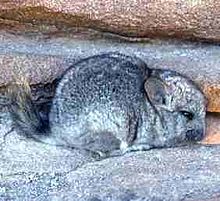Chinchillidae
| Chinchillidae Temporal range: Late Oligocene–Recent |
|
|---|---|
 |
|
| Chinchilla chinchilla (formerly Chinchilla brevicaudata) | |
| Scientific classification | |
| Kingdom: | Animalia |
| Phylum: | Chordata |
| Class: | Mammalia |
| Order: | Rodentia |
| Suborder: | Hystricomorpha |
| Infraorder: | Hystricognathi |
| Parvorder: | Caviomorpha |
| Superfamily: | Chinchilloidea |
| Family: |
Chinchillidae Bennett, 1833 |
| Genera | |
|
†Eoviscaccia |
|
†Eoviscaccia
Chinchilla
Lagidium
Lagostomus
†Pliolagostomus
†Prolagostomus
The family Chinchillidae is in the order Rodentia and consists of the chinchillas, the viscachas, and their fossil relatives. This family is restricted to southern and western South America, mostly living in mountainous regions of the Andes but one species living on plains. They are medium to large-sized rodents, weighing from 800 g (28 oz) to 8 kg (18 lb), with strong hind legs and large ears and a bushy tail. All species have thick, soft fur, which is considered valuable in some cultures.
Members of the family Chinchillidae are somewhat squirrel-like rodents varying in weight from 0.5 to 8 kilograms (1.1 to 17.6 lb). They have large eyes, medium-sized ears, soft dense fur and short bushy tails. The forelegs are shorter than the hind legs. The forefeet have four toes while the hind feet have four small-clawed toes in Lagidium and Chinchilla but three large-clawed toes in Lagostomus, a digging species. Their dental formula is 1/1, 0/0, 1/1, 3/3 and their incisors grow continually throughout their lives. Chinchillids are generally brownish-grey or grey on the dorsal (upper) surface and pale on the ventral (under) surface. Plains viscachas have distinctive black and white markings on their faces.
The Chinchillidae are native to South America. Chinchillas and mountain viscachas live in remote mountainous regions of Chile and Peru, on rocky surfaces and among boulders. Plains viscachas are found in the plains of Argentina, from the Gran Chaco area southwards to Patagonia.
Members of this family are herbivorous and live in colonies of up to several hundred individuals. Plains viscachas live in extensive networks of burrows on plains where it is said that ten viscachas can eat as much as does one sheep. Mountain viscachas and chinchillas live in craggy upland regions where they inhabit crevices among rocks and are skilled climbers. Although they can jump, they mostly move about by walking or running. They use vocalizations to communicate with each other, especially the plains viscachas.
...
Wikipedia
